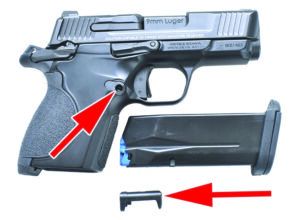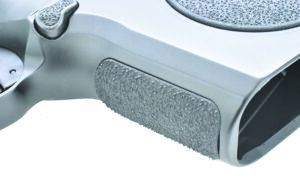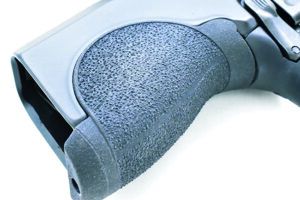For centuries, handguns were made of wood and metal — wood and brass, wood and iron, wood and steel, wood and stainless steel. Eventually, alloyed metals were substituted for steel, where possible, making things a bit lighter to carry. Then came polymer-framed pistols, which are ubiquitous today. Almost everyone makes one or more polymer models, so many of the shortcomings have been worked out. Why, then, are predominantly metal pistols still around? Because some of us still like the sculptured look that metal can provide, and some of us like the feel of metal in our hands. That “some of us” market seems to be large enough and vocal enough that manufacturers are starting to take notice once again. Springfield Armory introduced the updated SA-35 version of the classic Browning Hi-Power last year to great reviews and even better sales. Or just try to find a new SIG P210 Carry model at a real price.
In this metallic vein, we find it gratifying (and interesting) that sales of the traditional all-metal P938 still warrant production and upgrades. The latest top-of-the-line upgraded nameplate for most SIG pistols is called a Legion model. The Legions may have different sights, grips, or finishes to go along with other options more suitable for carry or competition. A pistol tested here, the SIG Sauer P938 Legion No. 938-9-Legion 9mm Luger, $699, is no exception. The standard P938 shows to have an overall height of 3.9 inches and weighs in at 16 ounces. This Legion model comes in with a height of 4.3 inches and weighs 17.8 ounces. Most of the difference is due to the magazine well added to the upgraded pistol. Attached to the mainspring housing via a single screw, it adds almost half an inch to the height. Couple that with the slightly extended base pad on the seven-round magazine, and the shooter stands a real chance of being able to place his pinky finger on the grip instead of below it.
Smith & Wesson brought out the Shield model sub-compact 9mm pistol in 2012 and upgraded it to the Shield 2.0 in 2019. Both of these thin concealment pistols have served the company and their buyers well. Some of our team have tested and carried various Shield models personally and were happy to do so. Then SIG Sauer came out with the P365 in a similar size, with a similar price and more bullets on board. S&W recently introduced the Shield Plus with a double-stack magazine as an answer to the P365. The pistols are great, but the size keeps growing. That can become a very real issue for those who live in warm-weather states and need to conceal what they carry. Tested here, the Smith & Wesson CSX 12615 9mm Luger, $549, may be some of the best of both worlds. The CSX is small, relatively lightweight and has great ergonomics, thanks to many of the modular options also available on the Shield. The CSX also has more magazine capacity.
We tested these two head to head at American Shooting Centers in Houston. We fired for accuracy at 15 yards by shooting multiple five-shot groups from a well-sandbagged Caldwell Pistolero shoot-ing rest. Practical capabilities were tested using multiple speed exercises fired at 5 and 7 yards. We tested using three different types of ammunition: 115-grain Remington Range ammo, Winchester Target & Practice FMJs, and SIG Sauer’s 115-grain V-Crown JHPs, which is a SIG-optimized load for short-barreled pistols. Here’s what we found:
Gun Tests Grade: A- (BEST BUY)
$549
S&W engineers put some thought into the bottom end of the CSX. Instead of polymer used for the Shield frame, the CSX frame is made of aluminum alloy with a matte-black finish. Also, S&W did a very good job of making this pistol ambidexterous. The CSX has slide-release levers and thumb safeties on both sides. We were very pleased with the design of the latter part. On many smallish pistols, manual thumb safeties can be miniaturized to the point where they are almost useless or where they require the user to perform some magical contortion with the thumb to operate the safety. On the CSX, the thumb safety is located far enough forward to reach and operate with a standard movement. Hoorah for S&W.
| Action Type | Semi auto, hammer fired |
| Overall Length | 6.1 in. |
| Overall Height | 4.25 in. |
| Maximum Width | 1.13 in. |
| Weight Unloaded | 17 oz. |
| Weight Loaded | 24.1 oz. |
| Slide Material | Stainless steel |
| Slide Retraction Effort | 13.5 lbs. |
| Receiver | Armornite-finished aluminum alloy |
| Front Strap Height | 2.0 in. |
| Back Strap Height | 2.6 in. |
| Barrel Length | 3.1 in. |
| Grip Thickness (Maximum) | 1.13 in. |
| Grip Circumference | 5.25 in. |
| Magazines | (1) 10 round, (1) 12 round |
| Rear Sight | Drift adjustable 2 dot |
| Front Sight | Drift adjustable 1 dot |
| Sight Radius | 4.5 in. |
| Trigger Pull Weight | 4.8 lbs. |
| Trigger Span | 2.6 in. |
| Safety | Ambi thumb, firing pin, and trigger |
| Warranty | Lifetime service policy |
| Telephone | (800) 331-0852 |
| Website | Smith-Wesson.com |
| Made In | U.S. |

The magazine release follows the same theme. The CSX’s mag release is not reversible. Instead, S&W included a complete second release easily changed out for left-handed shooters. Operating much like that on a 1911, the replacement catch even includes the spring and the latch pin so you don’t have to cannibalize the other release before changing them out.
Elsewhere, the CSX slide is made of stainless steel and is treated with Armornite, leaving it with a very durable dark finish. The top of the slide has been flattened and serrated to reduce glare. A witness hole is cut into the slide and barrel, allowing for a visible check of a loaded chamber.
The CSX provides the common three-dot pattern on sights that are both mounted in dovetails for lateral adjustment, if needed. Manufacturers have learned a few things about sights in the last hundred years. Luckily, we seldom see the miniscule rear sight matched with a nubbin of a front sight as on the early 1911s. The sights on the CSX protrude high enough to be very visible without being high enough to cause problems with our attempts to conceal or draw this pistol from deep concealment, such as a pocket. The forward edge of the rear sight can also provide a ledge for a tactical rack. Still, edges on the rear sight, as well as the rest of the slide, have been properly rounded. Cocking serrations are present at both front and rear of the slide.

The whole M&P series for S&W, including the very newest Shield variants, offers a variety of interchangeable grip inserts for different-sized hands. Two inserts are included with the CSX, along with instructions on how to change them. A pin (supplied) is inserted into a hole on the bottom of the grip panel and pressed in. The grip insert can then be removed and exchanged for the other. Both the grip inserts and a panel molded into the front strap are stippled and, shock of all shocks, we think S&W did them perfectly — not too aggressive and not too smooth.
The magazine well has been beveled to allow smoother mag changes. Two magazines, one 10-round and one 12-round version, are included. The 12-rounder has a sleeve on it that makes sure you don’t pinch parts of your pinky.

With all these positives, the CSX trigger left us looking for a bit more. Required compression was 4.9 pounds, which was only one-tenth pound more than on the SIG P938. Standard deviation over 10 pulls on our Lyman digital trigger gauge was the same at 6 ounces, but the Smith’s feel was different. The trigger on the CSX has a safety mounted on the face a la a Glock. We liked the fact that the safety on the CSX covered the full width of the trigger so that it doesn’t leave a thin lever projecting into our trigger finger. Movement was even shorter than on the SIG, but it was rough. We have spoken of “thousand-round trigger jobs” in the past. This trigger could well smooth itself in with enough use. We will have to see. We would also like to see the sear break when the trigger is a bit farther forward. Right now, it releases when the trigger is past the vertical, making it feel like things were operating slower or later than they really were. So much about triggers is perception, so our perception is what it is. In our opinion, the SIG won the trigger part of the test.
We liked the controls on the CSX, especially the manual thumb safety. We also liked the interchangeable grip panels. At the range, the CSX fired 15-yard average group sizes of 2.83 inches versus just under 2 inches for the P938, so we gave that win to the SIG as well. Required trigger compression was 4.8 pounds for the CSX. Though the P938 required 4.9 pounds for the same thing, the SIG felt smoother, we thought. At the same time, we liked the smooth, flat face on the CSX trigger. Function and reliability were 100%. Then there is the matter of ammo capacity, which the CSX won easily.
Our Team Said: We really liked several of the features offered in the CSX, chief among them being the magazine capacity. We graded down the CSX just a bit for showing slightly less accuracy than the SIG and a trigger we would like to be smoother. Then we graded it back up for all the functionality of the alloy frame. Depending on whether the shooter wants accuracy and speed or a pistol that more easily fits different hand sizes and shapes, our top choice could well go to the CSX.
9mm Luger Range Data
Our shooters fired these pistols at American Shooting Centers in Houston. We shot them for accuracy at 15 yards by firing multiple five-shot groups from a well-sandbagged Caldwell Pistol Rest assisted by a Mini DRC Fortune Cookie from Wiebad.com. We used a LabRadar chronograph to measure velocities.
| Remington Range 115-grain FMJ T9MM3B | SIG Sauer P938 Legion | Smith & Wesson CSX |
| Average Velocity | 1034 fps | 1023 fps |
| Muzzle Energy | 273 ft.-lbs. | 267 ft.-lbs. |
| Average Group | 1.54 in. | 2.55 in. |
| Best Group | 1.09 in. | 1.85 in. |
| Winchester Target & Practice 115-grain FMJ USA9MMVP | SIG Sauer P938 Legion | Smith & Wesson CSX |
| Average Velocity | 1094 fps | 1068 fps |
| Muzzle Energy | 306 ft.-lbs. | 291 ft.-lbs. |
| Average Group | 2.03 in. | 3.49 in. |
| Best Group | 0.99 in. | 2.79 in. |
| SIG Sauer V-Crown 115-grain JHP 9MMA1-365-20 | SIG Sauer P938 Legion | Smith & Wesson CSX |
| Average Velocity | 1114 fps | 1080 fps |
| Muzzle Energy | 317 ft.-lbs. | 298 ft.-lbs. |
| Average Group | 2.36 in. | 2.45 in. |
| Best Group | 1.66 in. | 2.12 in. |
DRILL DATA (5x5x5)
Process: Fire five shots from low ready at a 5-inch circle placed at 5 yards. Numbers are averages for four repetitions.| Pistol | Time to First Shot (seconds) | Split Average (seconds) | Total Time (seconds) |
|---|---|---|---|
| SIG Sauer P938 Legion | 0.865 | 0.235 | 1.805 |
| Smith & Wesson CSX | 0.965 | 0.259 | 2.000 |
Drill Data (5x8x7)
Process: Fire five shots from low ready at an 8-inch circle at 7 yards. Numbers are averages for four repetitions.| Pistol | Time to First Shot (seconds) | Split Average (seconds) | Total Time (seconds) |
|---|---|---|---|
| SIG Sauer P938 Legion | 0.86 | 0.22 | 1.74 |
| Smith & Wesson CSX | 1.110 | 0.24 | 2.070 |



























Great article on the GSX. I bought one which I carry in a pocket holster. Issues for me were:
1. Single action. Decades will a 1911 in competition as well as some carry have made the manual of arms 2nd nature.
2. Fits in pocket.
3. More effective round.
4. Reasonable cost.